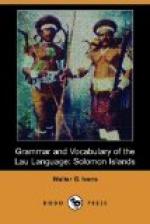7. Gi denotes plurality and follows the noun: na mwane gi the males. It may be separated from the noun: na doo nia gi his things; gi is used with the forms of the personal pronoun plural except those ending in lu.
8. Mwai is used with nouns of relationship only: mwai asi nia his brethren, ro mwai sasina brethren.
9. In Port Adam ote seems to be employed as a regular plural article: ote mwane gi you men. But it is a question whether ote is not properly employed of females only: ote aia nia his female relations, ote sasina his sisters, ote ai you women, ote ai gi you women.
10. A is used as a personal article with the names of males, both native and foreign: a Leo, a Joe. It is used also with doo thing: a doo so and so, a doo na the person.
Ni is used as a personal article with the names of females, both native and foreign: ni Alida, ni Mary. It is used also with certain nouns which denote women, where in Sa’a nga or the personal article a is used: ni te nau my mother, ni mwaemwane a man’s sister, a woman’s brother, ni aia female relations, ni doo the woman, ni mwela ne that woman. Ni is not used with afe wife, nor with geni female; it is not used with the plural.
NOUNS.
1. Nouns to which possessive suffixes may be added:
Certain nouns take the suffixed pronoun denoting the possessor. These are nouns denoting:
a. Parts of the body: lima hand, limagu my hand, aba arm, abamu thy arm, maa eye, maamu thy eye.
b. Position, end, middle, top: buri behind, burigu behind me, i dalumana in the midst, isingana its end, i kamena lobo beside the lake, i fafona on top of it.
c. Certain states or doings of men: life, death, speech, custom, goings: mae to die, maela death, maelana his death, baela speech, baelagu my word.
d. The word sasi brother, sasigu my brother, my sister. The other words denoting relationship employ the personal pronoun to denote possession.
2. Formation of nouns: Nouns which have a special termination showing them to be nouns substantive are (a) verbal nouns and (b) independent nouns.
a. Verbal nouns are formed from verbs by the terminations a, fa, la, ta: mae to die, maea death or sickness, maela death, bae to speak, baea word, baela speech, fanga to eat, fangaa feast, food, fangala food, mae to die, maemaefa sickness, nao to lead, naofa first, naofe mwela eldest child, also with suffixed pronoun naofana mwela; ta is seen in the root afuta all, which is used only with the suffixed pronoun, afutagera all of them, afutana na ai gi all the people. The termination la has a more or less gerundival force.




